This easy coconut cake recipe is absolutely decadent. This layer cake is unbelievably light and airy, covered with a fluffy coconut cream cheese frosting, and loaded with coconut flavor. Topped with more shredded coconut for both texture and decoration, this coconut cake is a simple yet elegant addition to any gathering.
One of the most important ingredients in this homemade coconut cake recipe is cake flour. It creates a wonderfully soft, light crumb. If you don’t have any on hand, don’t worry! I give you tips for making your own below. For more easy cake recipes, try my strawberry cake recipe, red velvet cake recipe, and lemon cake recipe.
What You Need To Make This Recipe
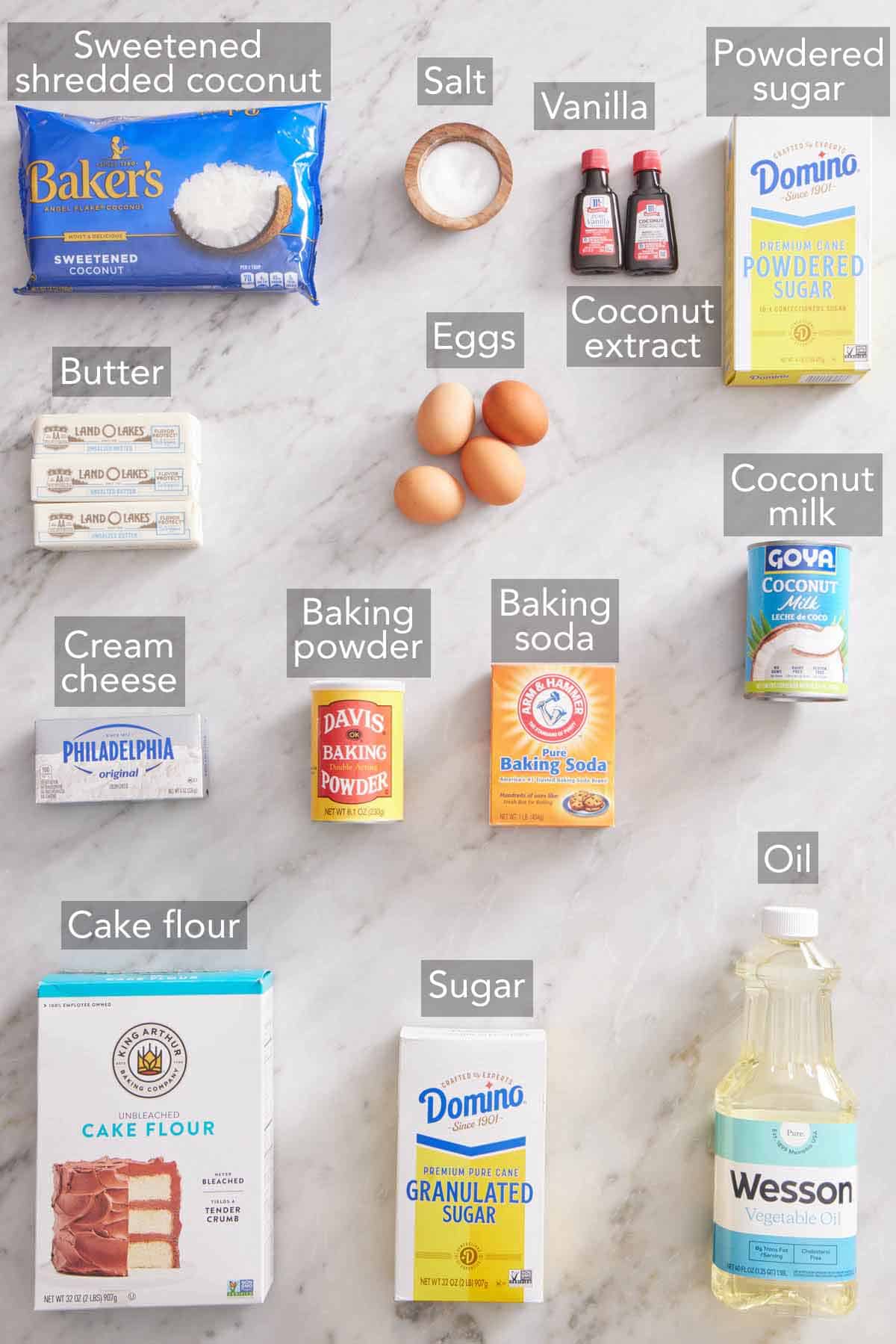
Here are the main ingredients you need to make the best coconut cake! You can find the full list of ingredients in the recipe card below.
Egg whites — using only egg whites instead of the whole egg makes the cake incredibly soft and airy.
Extracts — vanilla extract is common in cake recipes, but for this one, I use coconut extract as well for an even more intense coconut flavor.
Cake flour — I use all-purpose flour in plenty of my cake recipes, but cake flour is ideal in this recipe for the softest coconut cake layers.
Coconut milk — remember to use canned coconut milk, not the kind in a carton. Coconut milk adds extra coconut flavor, and its fat content contributes to the cake’s moist and tender crumb.
Coconut — use sweetened shredded coconut for the best flavor and texture. This will be stirred into the cake batter and used to decorate the cake.
Coconut cream cheese frosting — to make this coconutty twist on my favorite cream cheese frosting recipe, you need unsalted butter, brick-style cream cheese, vanilla and coconut extracts, a little salt, and confectioners’ sugar.
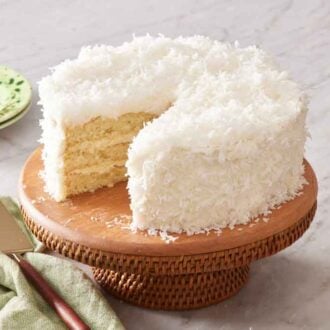
Coconut Cake Recipe
Video
Equipment
- 3 9" cake pan
- Electric or stand mixer
- Mixing Bowls
Ingredients
For the Cake:
- 3 cups cake flour (360g)
- 2 teaspoons baking powder
- ½ teaspoon baking soda
- 1 teaspoon salt
- 2 cups granulated sugar (400g)
- ½ cup unsalted butter softened (113g)
- ½ cup vegetable oil (120mL)
- 4 large egg whites lightly beaten
- 2 teaspoons vanilla extract
- ½ teaspoon coconut extract
- 1 cup coconut milk (240ml)
- 1 cup sweetened shredded coconut (100g)
For the Coconut Cream Cheese Frosting:
- 1 cup unsalted butter softened (227g)
- 8 ounces cream cheese room temperature (227g)
- 1 teaspoon vanilla extract
- ½ teaspoon coconut extract
- ¼ teaspoon salt
- 6 cups confectioners’ sugar (720g)
- 2½ cups sweetened shredded coconut (250g)
Instructions
For the Cake:
- Preheat the oven to 350°F. Butter and flour 3 (9-inch) round cake pans or spray with baking spray. Line the bottom of each pan with a circle of parchment paper.
- In a medium bowl, whisk to combine the flour, baking powder, baking soda, and salt. Set aside
- In a large mixing bowl or the bowl of a stand mixer with the paddle attachment, combine sugar, butter, and vegetable oil. Beat on medium speed for about 3 minutes, until light and creamy. Add the egg whites, vanilla, and coconut extract and mix until combined, about 1 minute.
- With the mixer on low speed, add about one-third of the flour mixture. Mix until completely combined. Add ½ of the coconut milk and mix until combined. Repeat adding another one-third of the flour mixture, remaining coconut milk mixture, then all of the remaining flour mixture. Stop and scrape down the bowl at least once during mixing, then mix until completely combined.
- Fold in the shredded coconut. Divide the batter evenly among the cake pans and smooth out to the sides with a spatula (the batter will be thick).
- Bake for 30 to 32 minutes, rotating the pans after 20 minutes, or until the center of the cake springs back when gently pressed.
- Let the cakes cool in the pan for 20 minutes. Carefully invert, remove the parchment paper, and continue cooling on a wire rack.
For the Coconut Cream Cheese Frosting:
- In a large mixing bowl or the bowl of a stand mixer with the paddle attachment, beat the butter and cream cheese on medium speed until creamy and fluffy, about 3 minutes. Add the vanilla extract, coconut extract, and salt. Beat until combined. Scrape down the sides and bottom of the bowl.
- Add the sugar 1 cup at a time, mixing on low speed between each addition. Once combined, scrape down the bowl, then mix on medium speed until fluffy, about 1 minute.
For the Assembly:
- Place one cake layer on a cake stand. Spread about 1 cup of frosting evenly over the top. Top with another cake layer and repeat with more frosting. Top with the remaining cake layer. Spread the remaining frosting all over the outside of the cake. Press the coconut to the frosting all over the top and sides of the cake to cover completely. Chill for 30 minutes for easy slicing, or keep refrigerated for up to 3 days or until ready to serve.
Notes
- I baked these layers with cake strips to create flat, even layers. You can follow my guide for how to bake flat cake layers using fabric strips, or you can make your own. If you bake without them, the layers will bake a bit faster. Bake for 23 to 25 minutes, rotating the pans after 15 minutes.
- Check your cake flour brand. I used King Arthur cake flour. If you are using Swans Down, the flour is a little bit lighter, so I recommend using 3¼ cups (364g) of flour in the cake batter.
- When using canned coconut milk, be sure to shake it vigorously before opening the can. The coconut solids in the can need to be fully combined with the liquid before mixing into the cake. If it still looks separated when you open the can, pour it into a bowl and whisk until combined and thickened throughout. You can gently warm it for 5 to 10 seconds in the microwave to help if needed.
- If your coconut extract is particularly strong, go on the lighter side by using less. Or, if you don’t like the flavor of coconut extract, you can leave it out altogether or use more vanilla extract!
- Don’t overmix the cake batter. This will cause the gluten to overdevelop, leading to tough cake layers.
Nutrition
How To Make Coconut Cake
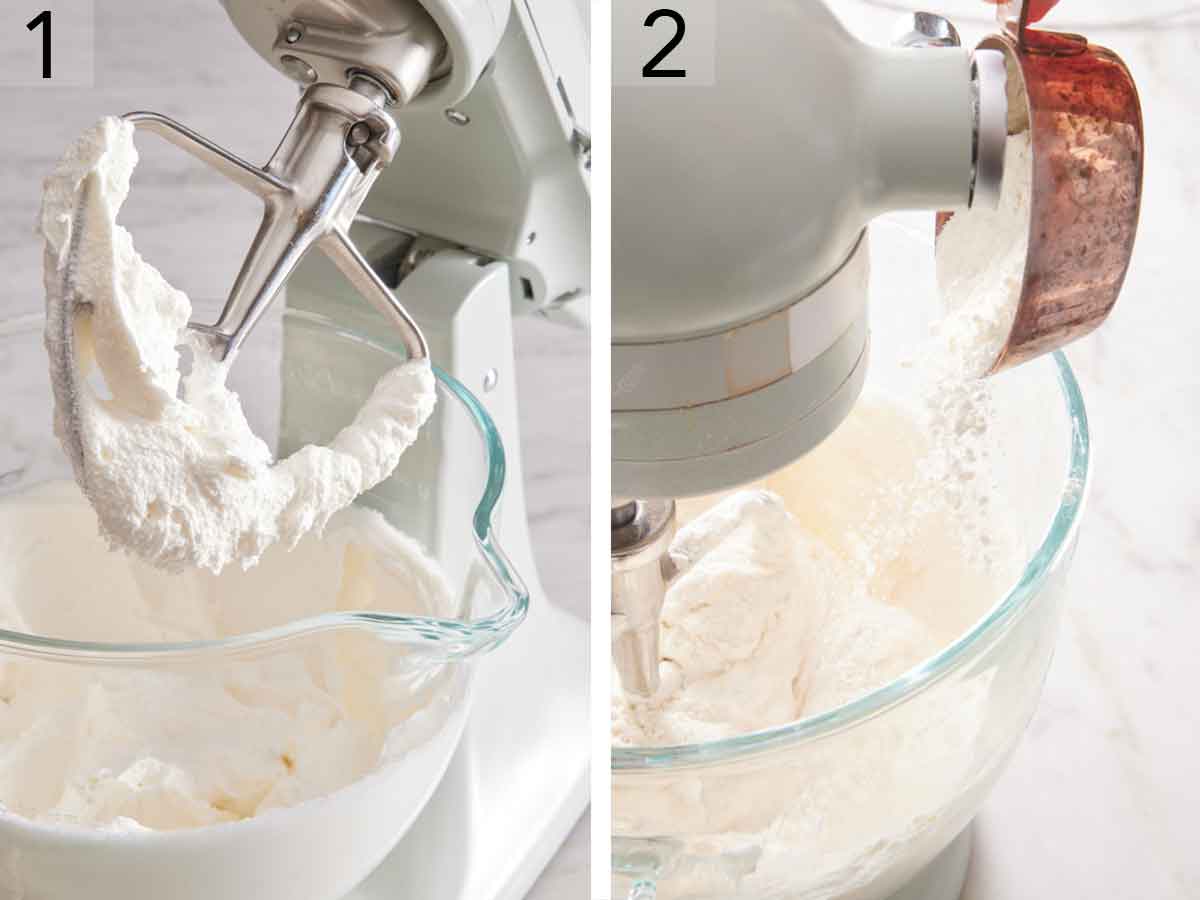
1. Whisk together the flour, leavening agents, and salt in a medium bowl. Add the sugar, butter, and vegetable oil to the bowl of a stand mixer with the paddle attachment (or to a large bowl with an electric mixer) and beat on medium speed until creamy. Then, mix in the egg whites, vanilla, and coconut extract.
2. Change the speed to low speed, add one-third of the dry ingredients to the wet ingredients, and mix.
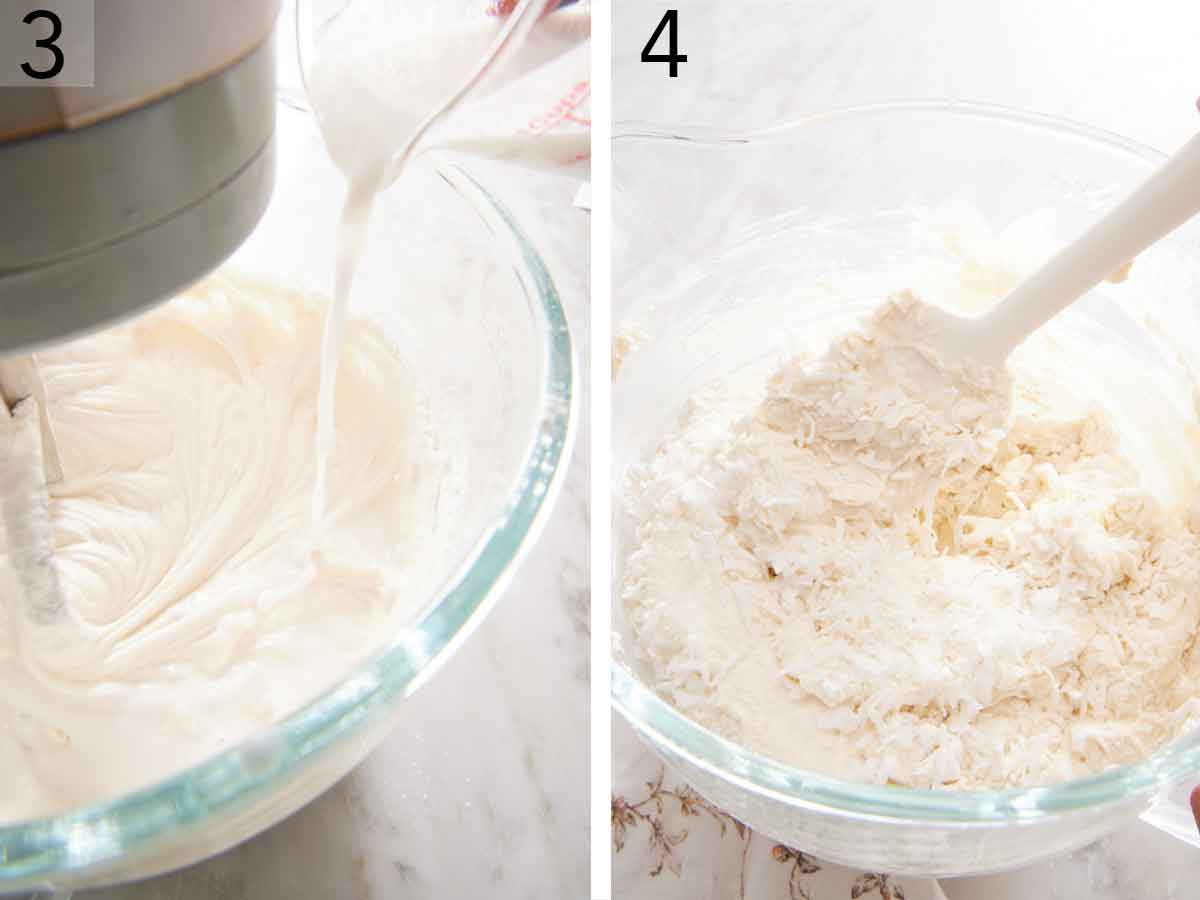
3. Add half of the coconut milk and mix, then repeat the process by adding another third of the dry ingredients, the rest of the milk, and the last of the flour mixture.
4. Add the shredded coconut and fold until well distributed.
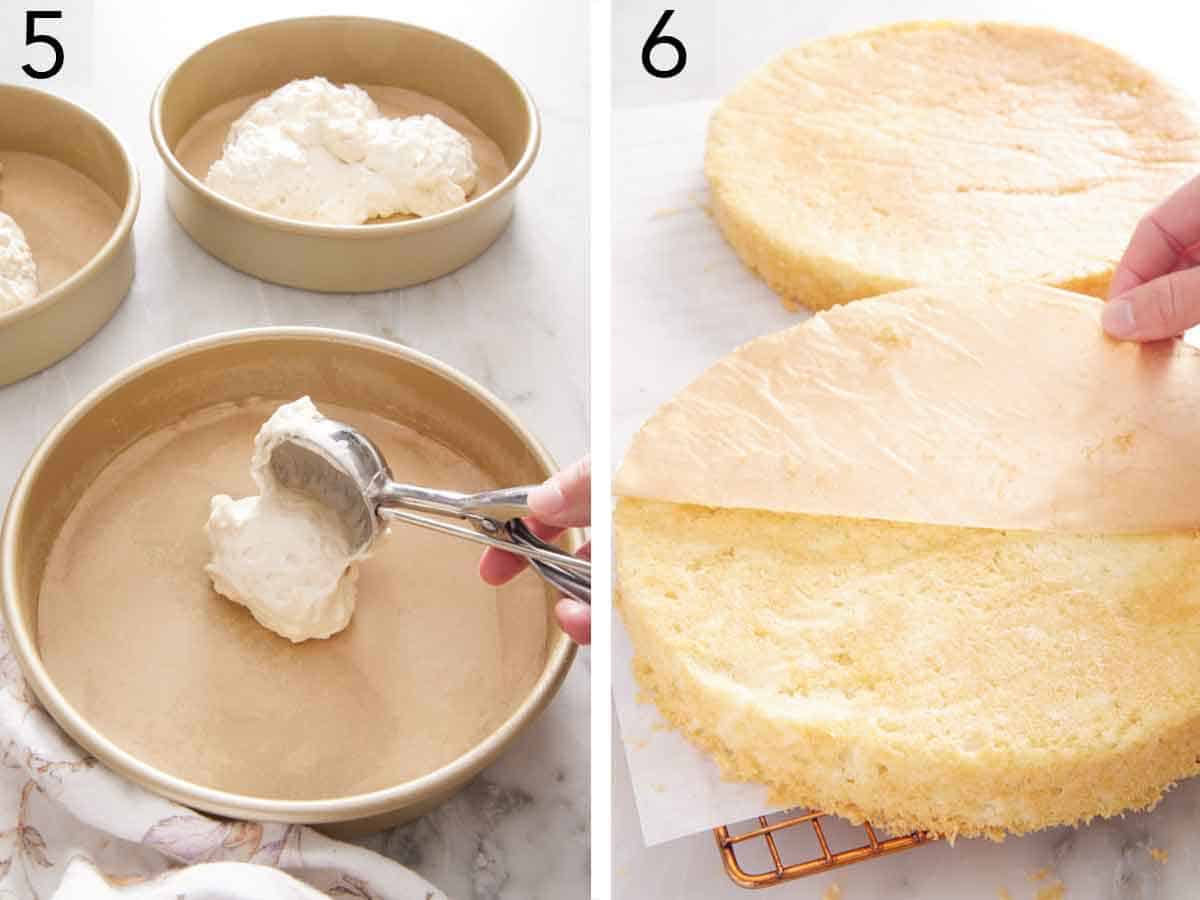
5. Divide the coconut cake batter evenly among three 9-inch cake pans greased and lined with circles of parchment paper.
6. Bake at 350°F until the center of the cake layers spring back when you gently press on them. Let the cakes cool in the pans for 20 minutes, then invert and remove the parchment paper. Allow to cool completely on a wire rack.
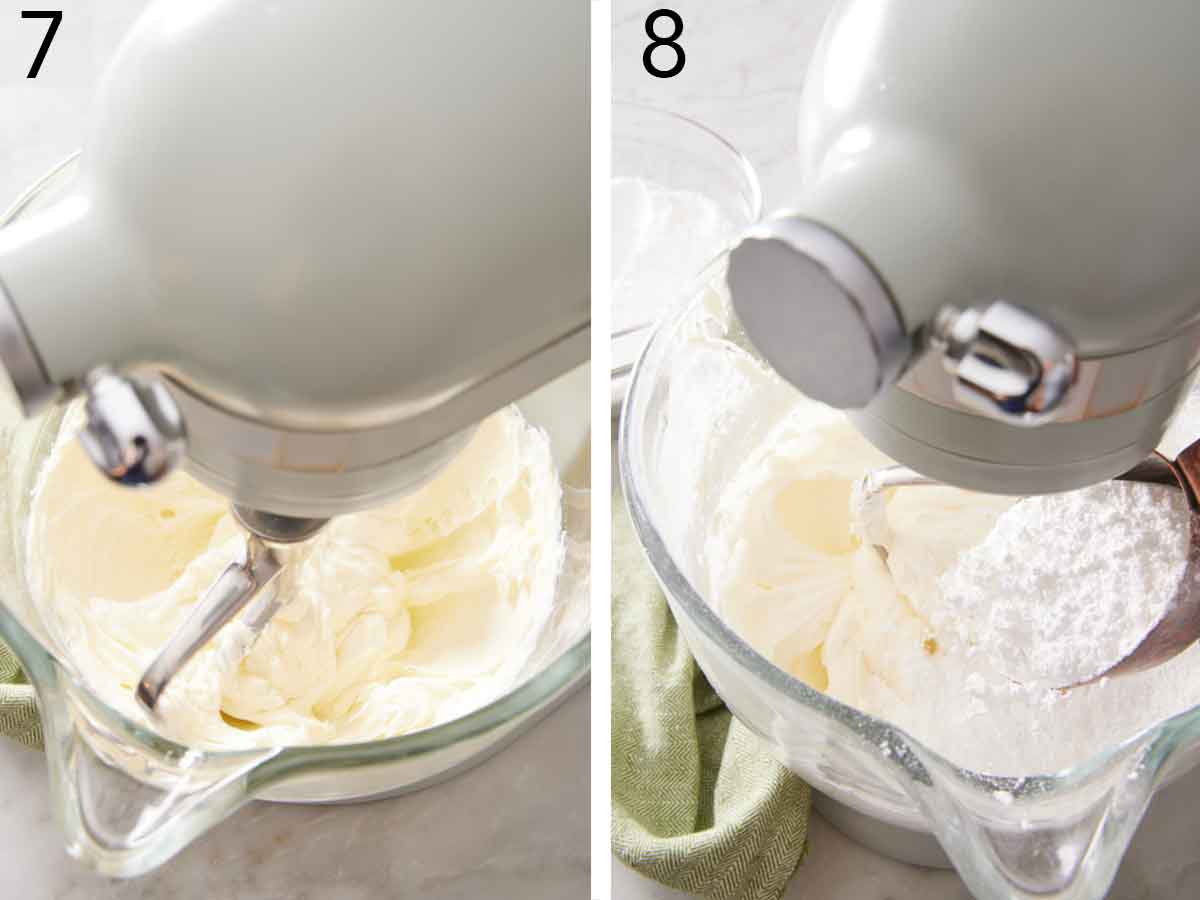
7. Make the coconut cream cheese frosting by beating the butter and cream cheese, then adding the extracts and salt. Beat to combine.
8. Add the powdered sugar in 1-cup increments and mix until fluffy.
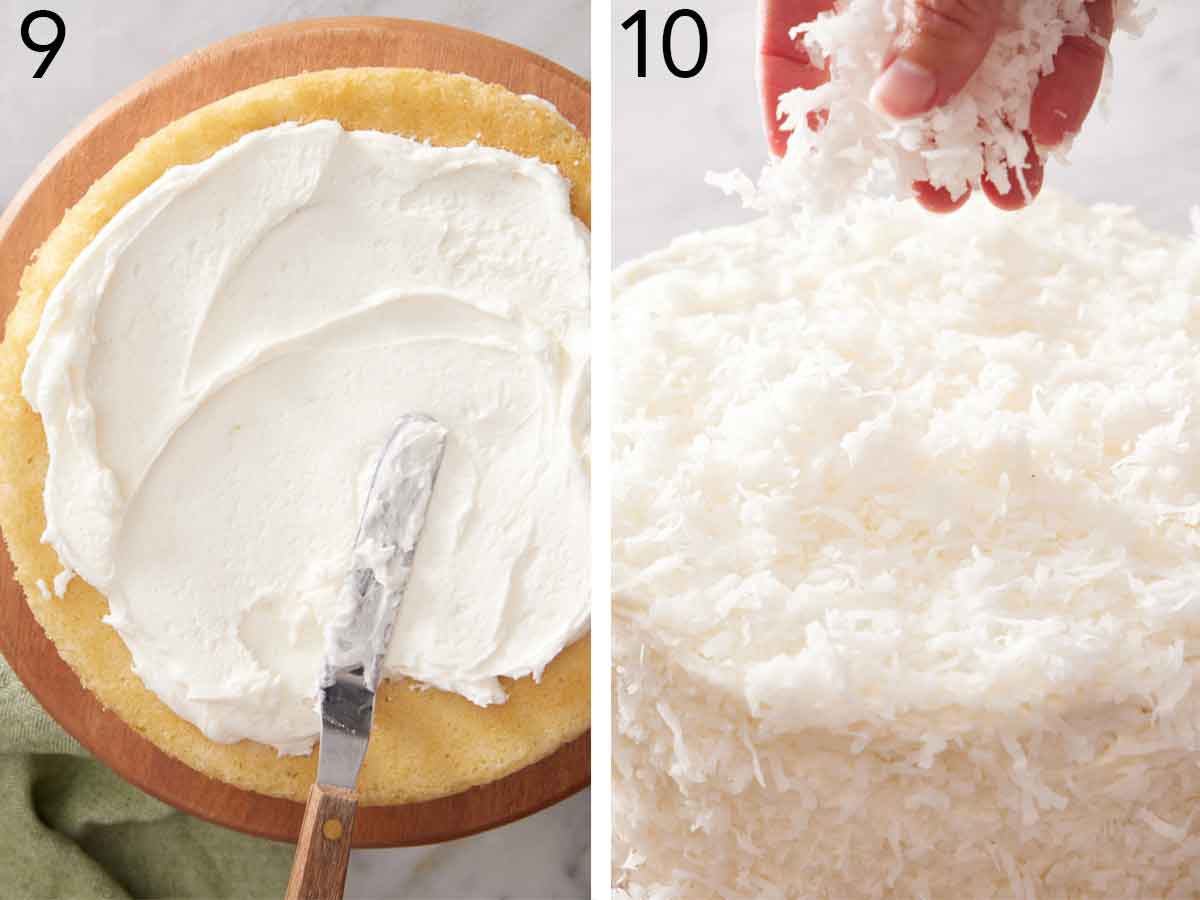
9. Place one cake layer on a cake stand and spread about 1 cup of frosting evenly over the top. Top with another cake layer and repeat. Top with the last layer and spread the rest of the frosting all over the outside of the cake (top and sides of the cake).
10. Press the shredded coconut onto the frosting all over the sides and top of the cake. Chill the coconut cake for 30 minutes before slicing.
What’s The Difference Between Flaked, Shredded, And Desiccated Coconut?
Shredded coconut is soft and sweet, and I use it in this recipe. Baker’s Flake Coconut is my preferred brand. Be sure to look for “sweetened” on the package of whichever brand you choose.
Flaked coconut is sometimes used interchangeably with shredded coconut, but it can also refer to large, long flakes of coconut shavings that are thicker than shredded coconut. You can use larger coconut flakes to decorate the outside of the cake if desired, like I do for my coconut cream pie! But use shredded sweetened coconut for the cake batter.
Desiccated coconut is much drier than either of the abovementioned coconut types, often processed to be much finer, and is typically unsweetened. This will make the cake dry, so avoid it in this recipe. Save it for coating lamingtons!
Do I Have To Use Cake Flour?
While cake flour is my preference in this recipe for the lightest, finest crumb cakes with the best texture, you can use all-purpose flour instead. Or, try my easy cake flour substitute made with all-purpose flour and cornstarch.
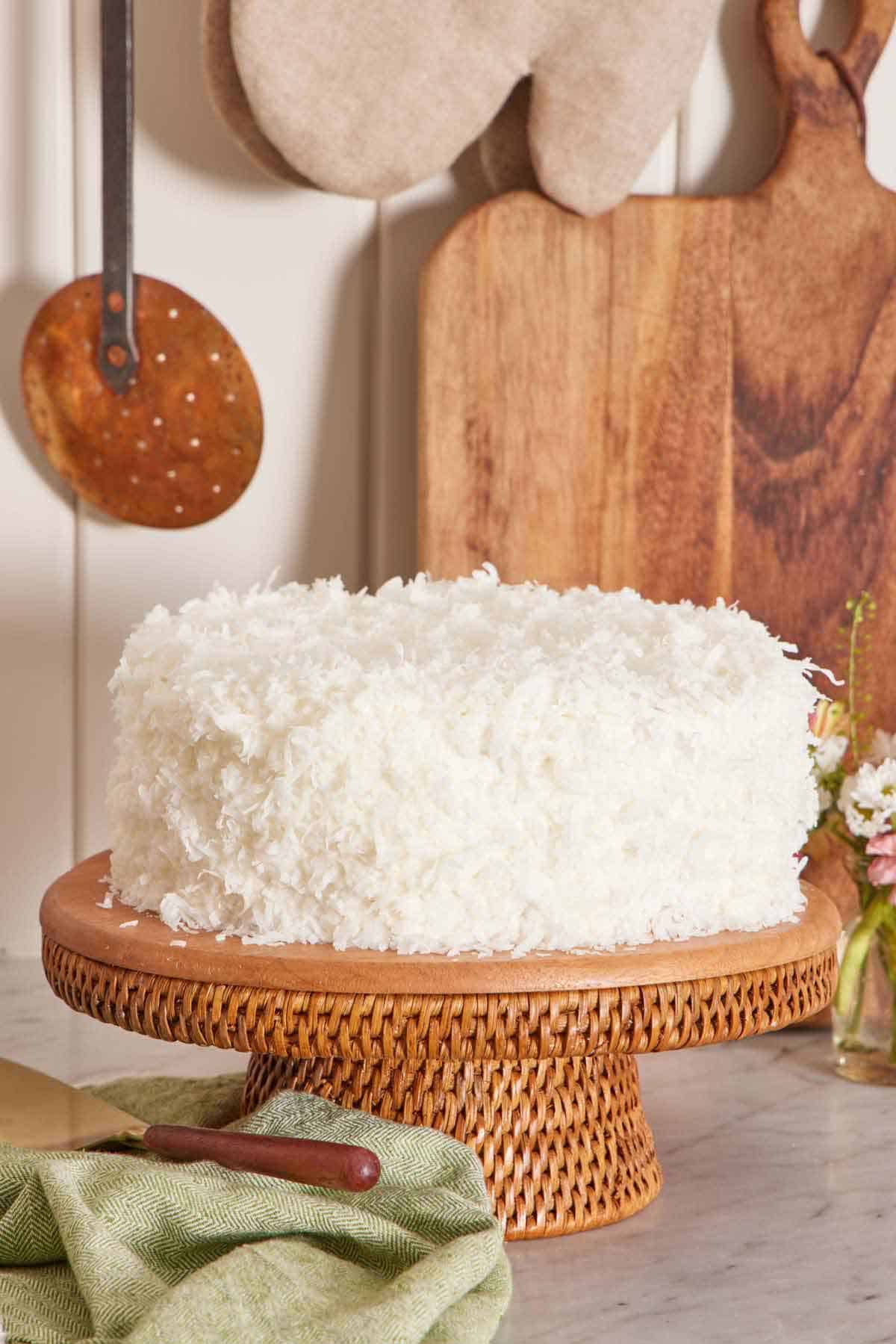
How Should I Decorate Coconut Cake?
Coconut cake is beautiful as is, covered with frosting and coconut. But you can add toasted coconut, buttercream roses, fresh edible flowers, or fresh fruit on top. Or check out my guide on how to decorate a cake for more ideas!
Can I Turn This Recipe Into Cupcakes?
You can, but I’d suggest making my coconut cupcakes instead. They have everything you love about this coconut cake in cupcake form with the proper ratios and baking instructions!
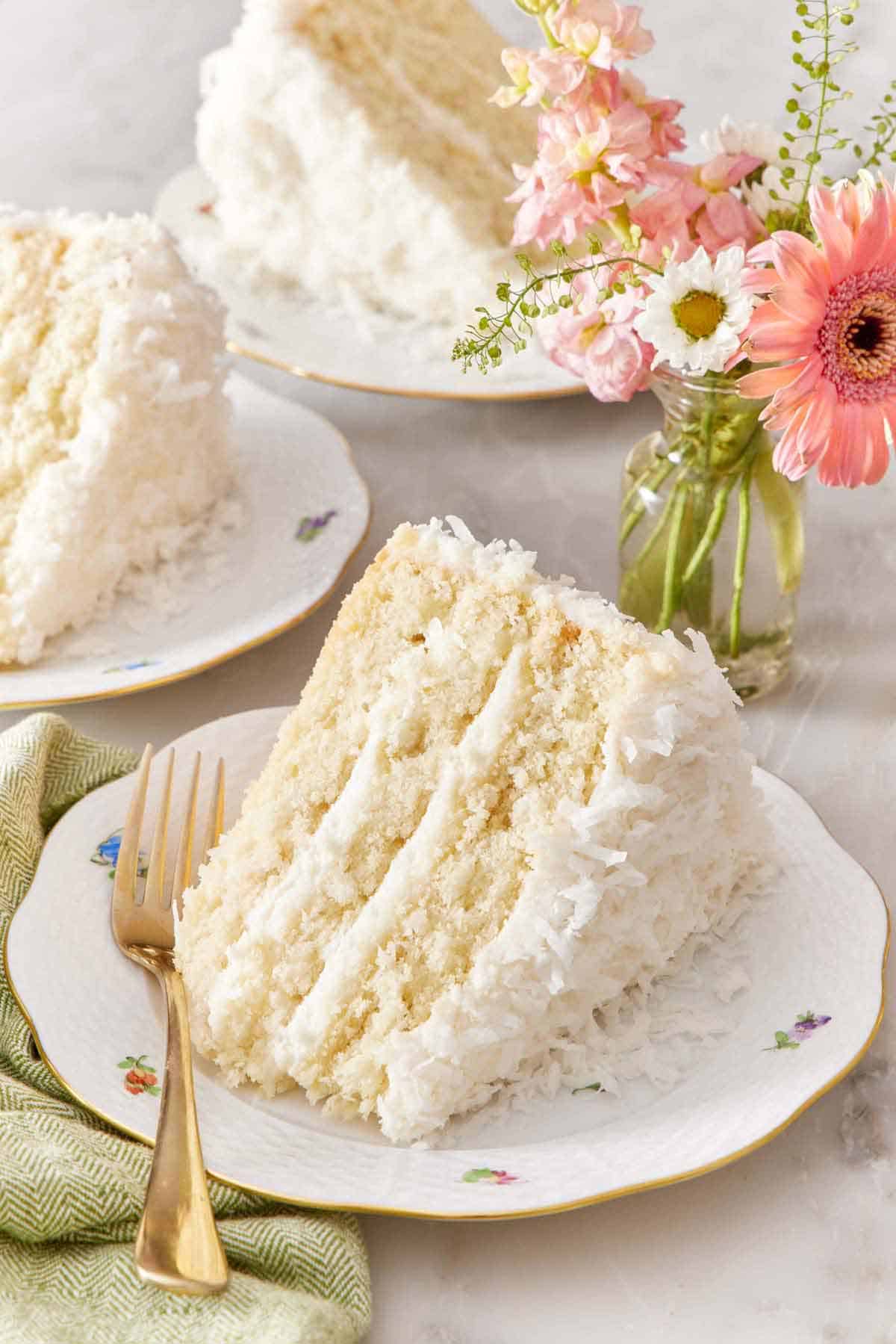
Pro Tips For Making This Recipe
- Measure the flour correctly. Using a scale is the most accurate method of measuring flour and will prevent you from accidentally using too much. If you don’t have a scale, fluff your flour with a spoon and spoon it into your measuring cup before leveling it off with a knife.
- Use room temperature ingredients. Set out the refrigerated ingredients in advance so they are easier to incorporate. See my post for how to soften butter if you forget, as butter typically takes the longest. These hacks work for cream cheese, too!
- For the milk in this recipe, you actually have a few options. You can use regular milk or buttermilk in place of the canned coconut milk. The buttermilk will produce a lighter crumb than regular whole milk, but regular milk will still result in a very delicious cake. I prefer using coconut milk for the added flavor!
- Use the egg yolks to make lemon curd! Lemon curd is actually delicious with coconut cake! Alternatively, use the egg yolks to make this homemade crème brûlée recipe.
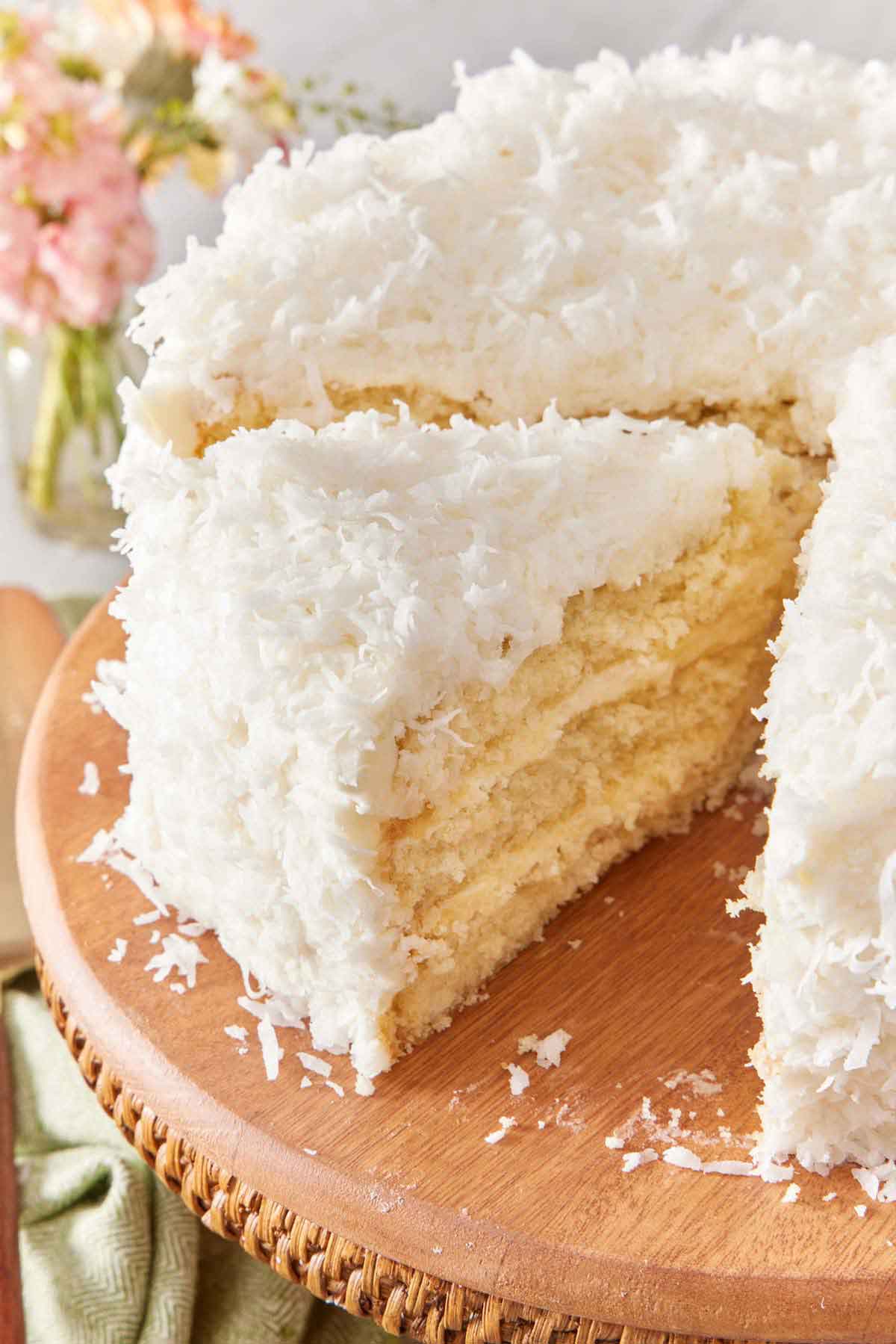
Frequently Asked Questions
Store leftover coconut cake tightly covered or in a large airtight container in the refrigerator for 4 to 5 days.
Yes! Wrap the frosted coconut cake (or individual slices) well with plastic wrap and aluminum foil and freeze it for up to 3 months. Thaw the cake in the refrigerator, bring it to room temperature, and serve.
I recommend sticking with sweetened shredded coconut, not unsweetened coconut. Not only does it add to the flavor of the cake, it also adds moisture. Unsweetened coconut is typically very dry and isn’t as enjoyable to eat when pressed all over the outside of the cake.
If you’ve tried this coconut cake recipe, then don’t forget to rate it and let me know how you got on in the comments below. I love hearing from you!



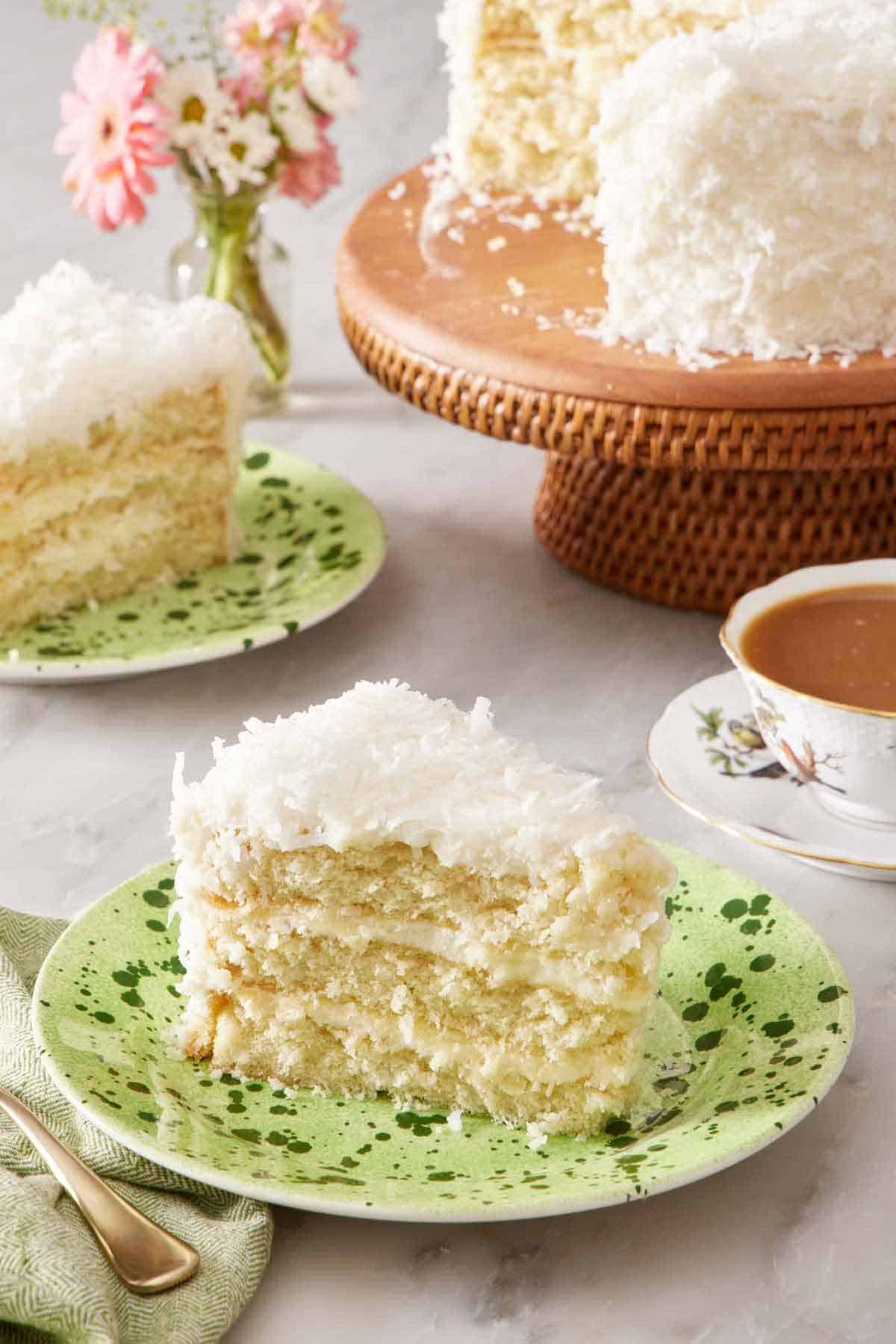
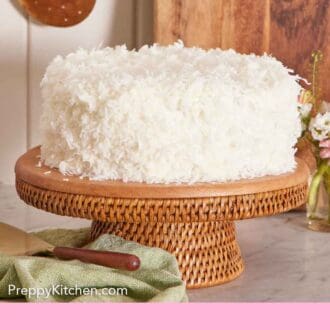
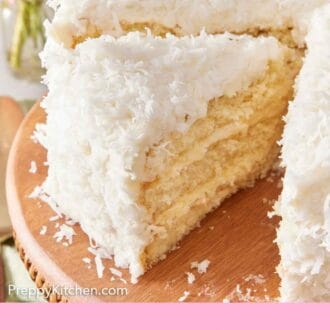
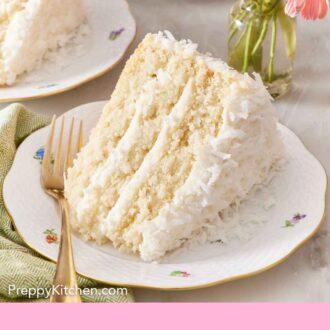
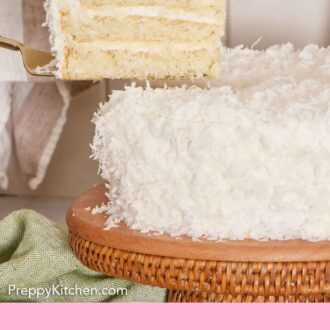
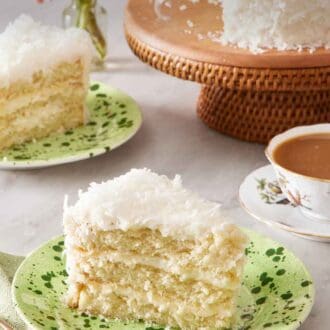
John H. says
I just tried this excellent recipe. It made me think of those old-fashioned coconut cakes with lemon filling, some a sort of lemon pudding, almost a lemon crème pâtissière, as I recall. It absolutely wasn’t lemon curd.
Maybe you could develop a good recipe. I haven’t had luck making a filling I like, even from vintage recipes.
Anika says
Any worries in adding some toasted walnuts into the cake batter? My father requested a very special walnut/coconut cake for his birthday and this recipe sounds perfect! Thank you!
Denise says
I like a coconut cake for Easter dinner. Over the past 5-6 years I have tried a different recipe every year and have never been satisfied. This year I made your cake and loved it!! The flavor was perfect, the texture light and the icing wonderful! I recently found your website and can’t wait to try the lemon, the strawberry, the Easter Egg, the Oreo and the Lavender Cake. . . My only problem — who to serve them to since we are sequestered with CoVid.
My cake did have slightly crunchy edges and top–I measured carefully and watched closely so not sure what happened? As I put the toasted coconut between layers it did not distract from the flavor. Thanks for a wonderful recipe!!
Bea says
I love coconut cake, pie or anything almost. My recipe is very similar to yours I don’t use the coconut flour and I use cake flour not ap flour for the frosting I make a coconut whipped cream with toasted coconut. What I do instead of the coconut flour is I grind toasted coconut. It’s absolutely the best coconut cake. I want you to try mine .. I think you would love it. I haven’t ever used cake strips although I’ve got a gazillion from people. I turn the oven down by 25° it keeps them flat and beautiful. I love your blog!!!!
Justin Rudd! says
I made your cake tonight, and it’s delicious. Your buttercream recipe here says “Italian meringue buttercream,” but I thought your recipe is for “Swiss meringue buttercream.” What’s the difference?
Adam says
https://www.cupcakeproject.com/italian-buttercream-swiss-buttercream-french-buttercream-frostings/
Really good explanation of the three basic European buttercreams and how they’re made